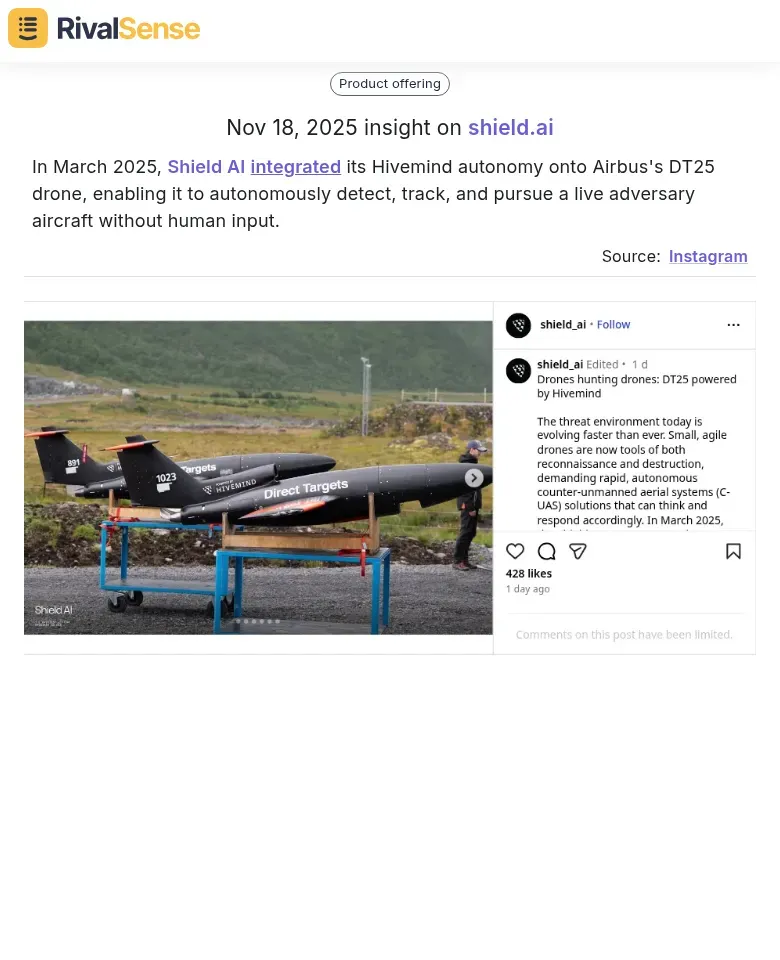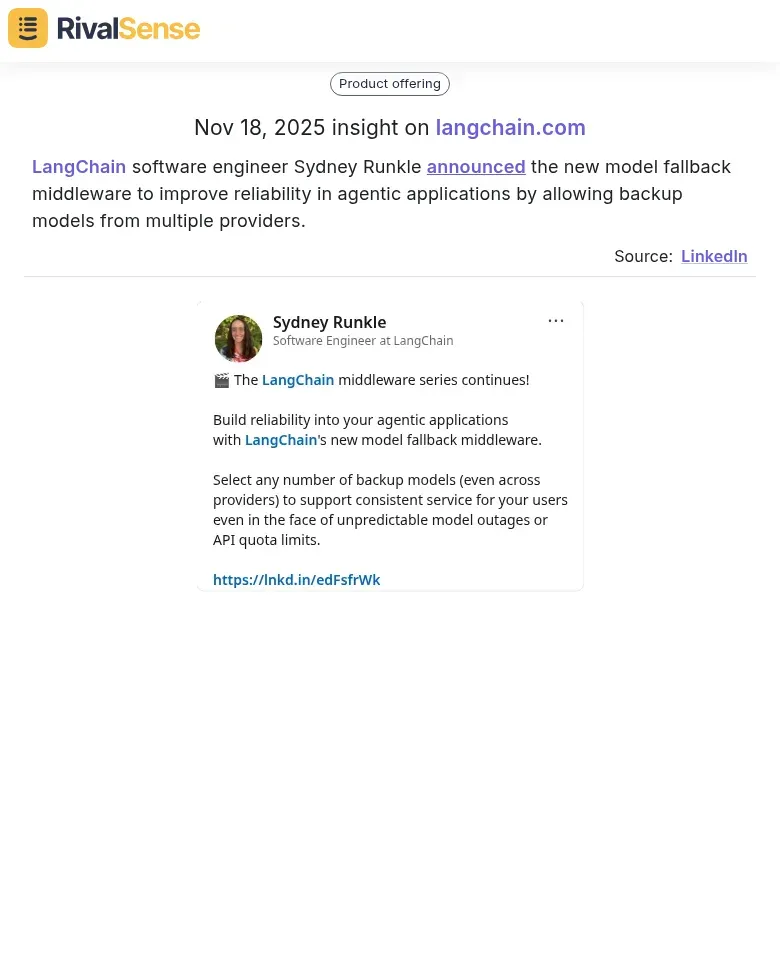The Ultimate Guide to Key Account Tracking in Salesforce
Last updated November 20, 2025
Written by Gary Smith, CEO
AT A GLANCE
Tracking key accounts effectively in Salesforce is crucial for B2B companies aiming to maintain competitive advantage and drive revenue growth. While Salesforce provides powerful CRM capabilities, many organizations struggle with comprehensive key account monitoring that goes beyond basic opportunity tracking. Effective key account tracking requires visibility into not just your own sales activities, but also understanding the competitive landscape and market dynamics affecting your most valuable customers.
WHY KEY ACCOUNT TRACKING MATTERS
Key accounts typically represent 80% of your revenue, making them critical to your business success. Traditional Salesforce tracking often focuses on internal metrics like pipeline stages and close dates, but misses crucial external factors that impact account health and retention. By integrating competitive intelligence, you can proactively address threats and capitalize on opportunities to strengthen these relationships.
PRACTICAL STEPS FOR EFFECTIVE KEY ACCOUNT TRACKING IN SALESFORCE
Step 1: Define Your Key Account Criteria
Establishing clear criteria helps prioritize resources and focus efforts on high-value accounts. This foundational step ensures that your tracking efforts align with business objectives and strategic goals.
Checklist for Identifying Key Accounts:
- ✅ Revenue contribution (top 20% of customers)
- ✅ Strategic importance to your business
- ✅ Growth potential and expansion opportunities
- ✅ Competitive vulnerability
- ✅ Relationship strength and executive sponsorship
Step 2: Set Up Custom Objects and Fields
Customizing Salesforce with tailored objects and fields enables deeper insights into account dynamics. This setup allows for automated tracking of critical metrics that influence account health and retention.
Create custom objects in Salesforce to track:
- Account health scores
- Competitive landscape within each account
- Key decision-makers and influencers
- Contract renewal dates and terms
- Product usage and adoption metrics
Pro Tip: Use formula fields to automatically calculate account health scores based on multiple factors including revenue trends, support ticket volume, and engagement metrics.
Step 3: Implement Opportunity Tracking with Competitive Context
Going beyond basic sales metrics is essential for comprehensive key account management. Incorporating competitive context helps anticipate challenges and refine your approach based on market realities.
Key Metrics to Monitor:
- Competitor Activity: Are your competitors actively pursuing your key accounts?
- Market Changes: Regulatory updates, industry shifts, or economic factors affecting the account
- Relationship Changes: Management changes, organizational restructuring
- Product Usage: Adoption rates, feature utilization, satisfaction scores
Step 4: Build Comprehensive Dashboards
Dashboards provide a centralized view of account performance and external influences. They enable quick decision-making by visualizing data from both internal and external sources.
Create dedicated key account dashboards that combine:
- Internal Salesforce data (opportunities, activities, support cases)
- External market intelligence
- Competitive positioning
- Account health indicators
Example Dashboard Components:
- Revenue trends vs. targets
- Competitor mentions and activities within the account
- Relationship strength indicators
- Risk assessment scores
- Upcoming contract renewals
BEYOND INTERNAL TRACKING: THE COMPETITIVE INTELLIGENCE GAP
While Salesforce excels at tracking internal sales activities, most companies struggle with monitoring external factors that impact key account relationships. This gap can lead to missed opportunities and increased vulnerability to competitor moves. Competitive intelligence tools like RivalSense bridge this divide by providing real-time insights into market dynamics.
What Traditional Salesforce Tracking Misses
Standard Salesforce implementations focus heavily on internal processes but overlook critical external elements. Understanding these limitations is the first step toward building a more robust tracking system.
Most Salesforce implementations focus on:
- Internal pipeline management
- Sales team performance
- Customer interaction tracking
But they typically lack:
- Competitor product launches targeting your key accounts
- Pricing changes that could affect renewal negotiations
- Partnership announcements that might shift account dynamics
- Media mentions and industry developments
How RivalSense Complements Your Salesforce Strategy
RivalSense enhances your Salesforce setup by delivering actionable competitive intelligence directly to your team. This integration ensures that external factors are consistently considered in account management decisions.
RivalSense fills this critical gap by tracking competitor activities across 80+ sources, including:
- Company websites and social media
- Product launch announcements
- Pricing updates
- Event participations
- Partnership announcements
- Regulatory changes
- Management team updates
- Media coverage
Practical Integration Tip: Use RivalSense's weekly email reports to update key account records in Salesforce with relevant competitive intelligence. Create custom fields to track competitor mentions and activities for each key account.
Real-World RivalSense Insights for Strategic Advantage
Incorporating real competitive intelligence into your key account strategy can provide early warnings and strategic opportunities. Here are examples of insights tracked by RivalSense that demonstrate the value of external monitoring.
-
Product Launch Insight:

OpenAI's Adam Goldberg announced on November 19 that GPT-5.1-Codex-Max is now available in Codex for CLI, IDE extension, cloud, and code review, with API access coming soon. This type of insight is valuable because it alerts you to new competitor offerings that could directly impact your key accounts, allowing you to prepare counter-strategies and reinforce your value proposition. -
Partnership and Integration Insight:

In March 2025, Shield AI integrated its Hivemind autonomy onto Airbus's DT25 drone, enabling it to autonomously detect, track, and pursue a live adversary aircraft without human input. This insight is crucial as it highlights strategic partnerships that may shift competitive dynamics, helping you assess potential threats to your accounts and explore similar collaborations. -
Feature and Reliability Insight:

LangChain software engineer Sydney Runkle announced the new model fallback middleware to improve reliability in agentic applications by allowing backup models from multiple providers. Tracking such updates is valuable because it reveals competitor innovations in product reliability, enabling you to benchmark your offerings and address any gaps that could affect account satisfaction.
ADVANCED KEY ACCOUNT TRACKING STRATEGIES
Strategy 1: Proactive Risk Assessment
Proactively assessing risks helps mitigate threats before they impact your key accounts. This approach involves continuous monitoring and swift response to external changes.
Implementation Steps:
- Set up automated alerts for competitor activities targeting your key accounts
- Monitor industry news and regulatory changes affecting your top customers
- Track management changes that could impact relationships
- Use competitive intelligence to anticipate renewal challenges
Strategy 2: Competitive Positioning Analysis
Understanding your position relative to competitors is key to defending and growing key accounts. Regular analysis ensures your strategies remain aligned with market realities.
Checklist for Each Key Account:
- [ ] Identify primary competitors in the account
- [ ] Track competitor product updates and pricing changes
- [ ] Monitor competitor executive movements
- [ ] Document competitor strengths and weaknesses
- [ ] Update competitive positioning in account notes
Strategy 3: Account Health Scoring
A robust scoring system provides an objective measure of account stability and growth potential. Incorporating competitive factors ensures a holistic view of account health.
Create a weighted scoring system that includes:
- Revenue performance (40%)
- Product adoption (25%)
- Support satisfaction (15%)
- Competitive vulnerability (20%)
Pro Tip: Use RivalSense data to accurately assess the competitive vulnerability component of your account health scores.
CUSTOMIZING YOUR SALESFORCE ENVIRONMENT
Custom Objects and Fields
Tailoring Salesforce to your specific needs enhances the depth and accuracy of key account tracking. Custom elements allow for more granular data capture and analysis.
Consider creating these custom elements:
- Competitor Tracking Object: Link to key accounts
- Market Intelligence Fields: Track external factors
- Risk Assessment Scores: Automated calculations
- Competitive Alert History: Log relevant competitor activities
Automation and Workflows
Automation streamlines processes and ensures timely responses to critical events. Well-designed workflows reduce manual effort and improve consistency in account management.
Set up automated processes to:
- Flag accounts when competitor activities are detected
- Alert account managers about relevant market changes
- Update account health scores based on new intelligence
- Trigger renewal preparation workflows
COMMONLY ASKED QUESTIONS
How can I integrate external competitive intelligence with Salesforce?
Integrating external data requires a combination of manual processes and tool-based solutions. Consistency is key to maintaining accurate and up-to-date account records.
Tools like RivalSense provide weekly email reports that can be manually reviewed and entered into Salesforce, or you can explore API integrations for automated data syncing. The key is establishing a consistent process for updating account records with relevant competitive intelligence.
What's the difference between key account tracking and regular opportunity management?
Key account tracking encompasses a broader, more strategic view compared to standard opportunity management. It focuses on long-term relationship health and external influences.
Key account tracking takes a holistic view that includes:
- Long-term relationship management
- Competitive positioning
- Market dynamics
- Strategic importance
- Multiple opportunities and relationships
Regular opportunity management typically focuses on individual deals and short-term sales cycles.
How often should I review key account intelligence?
Regular reviews ensure that your strategies remain relevant and responsive to changes. Establishing a routine helps maintain focus on critical accounts.
Recommended Frequency:
- Daily: Quick scan of competitive alerts
- Weekly: Comprehensive review of RivalSense reports and update Salesforce records
- Monthly: Strategic account review meetings
- Quarterly: Deep-dive competitive analysis
WHAT TO DO NEXT
Immediate Action Steps
Taking prompt action helps close gaps in your key account tracking process. Start with an audit and build from there to integrate competitive intelligence effectively.
- Audit Your Current Process - Evaluate what competitive intelligence you're currently capturing in Salesforce
- Identify Key Account Gaps - Determine which external factors you're not tracking
- Explore Competitive Intelligence Tools - Consider tools like RivalSense that specialize in competitor tracking
- Develop Integration Strategy - Plan how to incorporate external intelligence into your Salesforce workflow
- Train Your Team - Ensure account managers understand how to use competitive intelligence effectively
Long-term Strategy
A sustained approach ensures ongoing protection and growth of key accounts. Focus on continuous improvement and adaptation to market changes.
- Implement regular competitive intelligence reviews
- Develop account-specific competitive positioning
- Create automated alert systems
- Build comprehensive key account dashboards
- Establish continuous improvement processes
FINAL THOUGHTS
Effective key account tracking in Salesforce requires combining robust internal CRM capabilities with comprehensive external market intelligence. While Salesforce provides excellent tools for internal tracking, complementing them with competitive intelligence solutions like RivalSense offers a complete picture needed to protect and grow your most valuable customer relationships. Remember, your competitors are constantly working to win your key accounts; staying informed about their activities gives you the strategic advantage to maintain strong relationships and drive continued growth.
To start gaining these insights and enhancing your key account strategy, try RivalSense for free at https://rivalsense.co/ and get your first competitor report today.
Gary Smith is the CEO of The Gary Smith Partnership (GSP), where he leads the development of Salesforce-native apps that make the platform work how sales teams need it to. With over 25 years of experience in Salesforce implementation, he regularly shares practical insights to help teams sell smarter and forecast more accurately.
Follow me on LinkedIn for more insights on sales strategy and competitive intelligence.
📚 Read more
👉 Essential Competitor Analysis Strategies for Investment & Wealth Management
👉 How RivalSense Helps Counter Talent Loss: A føtex Case Study
👉 Turn Competitor Website Changes into Key Account Wins
👉 Master Mystery Shopping: A Step-by-Step Guide to Outmaneuvering Trust Management Competitors
👉 Win-Loss Analysis: Boost Productivity with Financial Competitor Insights
